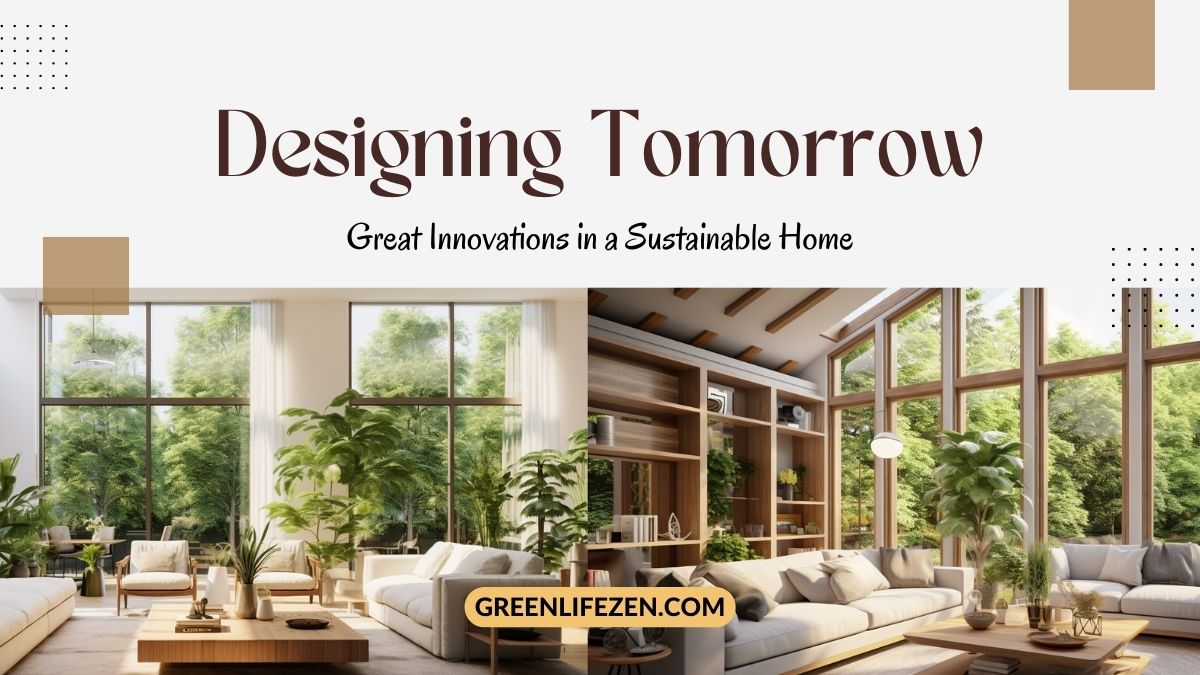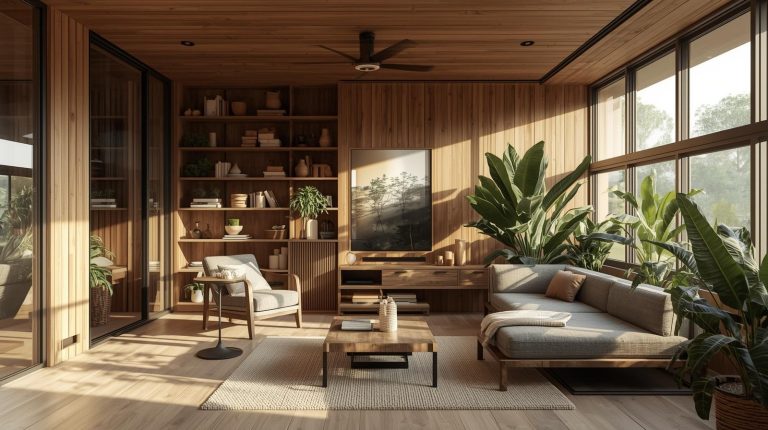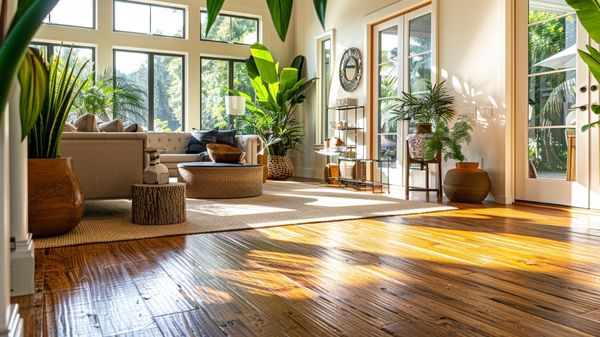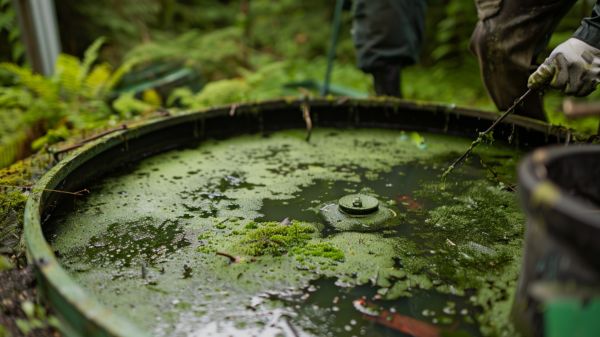Welcome to the future of sustainable living. In this article, we’ll explore the incredible innovations that are transforming houses into eco-friendly havens. Get ready to be inspired as we delve into the world of designing a sustainable home.
Discover how you can create a space that not only reduces your carbon footprint but also enhances your quality of life. It’s time to embrace the possibilities and join the movement towards a more sustainable and fulfilling future.
Revolutionize Your Interiors with AI: Experience a Stunning Redesign in Just 30 Seconds, Guaranteed!

Key Takeaways
- Location and site selection are crucial in maximizing energy efficiency and minimizing environmental impact.
- Optimizing the size and layout of a sustainable home reduces unnecessary space and promotes functionality.
- Proper window orientation, shading devices, and the use of natural light and heat play a significant role in sustainable home design.
- Incorporating renewable energy sources, such as solar panels, and utilizing smart home technology are innovative ways to create a more sustainable home.
Understanding Sustainable Homes
Understanding sustainable homes is crucial in today’s world where environmental consciousness is on the rise. A sustainable home is designed to minimize its impact on the environment by utilizing renewable energy sources, reducing waste, and promoting energy efficiency.
What is a Sustainable Home?
Do you know the key features of a sustainable home and how it can positively impact your environment? Sustainable homes are designed with the goal of minimizing their environmental footprint. Here are some important elements of a sustainable home design:
- Energy efficiency: Incorporating renewable energy sources such as solar panels can significantly reduce energy consumption.
- Water conservation: Implementing technologies like rainwater harvesting and low-flow fixtures can help reduce water usage.
- Efficient insulation: Proper insulation helps maintain a comfortable indoor temperature and reduces the need for excessive heating or cooling.
- Use of sustainable materials: Opting for eco-friendly materials like bamboo or recycled materials reduces resource depletion.
- Waste reduction: Implementing recycling systems and composting can greatly reduce waste sent to landfills.
Related Post: Eco-Friendly Kitchen: How To Design A Sustainable Dream Kitchen.
Types of Sustainable Homes
You can explore various types of sustainable homes, such as passive houses, net-zero energy homes, green homes, eco-friendly modular homes, and sustainable straw bale houses. Each type offers unique features and benefits, contributing to a greener and more sustainable future.
Passive houses, for example, are designed to maximize energy efficiency, relying on insulation, ventilation, and solar gain to maintain a comfortable temperature without the need for traditional heating or cooling systems.
Net-zero energy homes generate as much energy as they consume, utilizing renewable energy sources like solar panels or wind turbines.
Green homes prioritize environmental friendliness through the use of sustainable materials, energy-efficient appliances, and water-saving fixtures.
Eco-friendly modular homes are built off-site, reducing waste and environmental impact.
Lastly, sustainable straw bale houses use straw bales as insulation, providing excellent thermal performance.
With the increasing focus on sustainability, sustainable home builders are continuously innovating new designs and products to create self-sustaining homes that benefit both the environment and the homeowners.
Benefits of a Sustainable Home
Living in a sustainable home can result in up to 50% lower energy bills compared to traditional homes. This not only helps you save money, but also reduces your environmental impact. By making simple changes and embracing sustainable home goods, you can create a more eco-friendly living space.
Here are five benefits of a sustainable home:
- Reduced energy bills: Sustainable homes are designed to be energy efficient, resulting in significant savings on your monthly utility bills.
- Reduced environmental impact: Sustainable homes use renewable energy sources and minimize waste, helping to protect the planet for future generations.
- Improved indoor air quality: Sustainable homes prioritize good ventilation and use non-toxic materials, ensuring cleaner and healthier air for you and your family.
- Increased property value: As sustainability becomes more important to buyers, investing in a sustainable home can increase its resale value.
- Contributing to a healthier planet: By choosing to live sustainably, you’re actively participating in the global effort to combat climate change and create a more sustainable future.
Incorporating sustainable home decor and making conscious choices on how to be more sustainable in your home can have a profound impact on your quality of life and the world around you. So, why not start making a difference today?
Designing a Sustainable Home
When designing a sustainable home, there are several key factors to consider.
First, the location and site selection play a crucial role in maximizing energy efficiency and minimizing environmental impact.
Second, the size and layout of the home should be optimized to reduce unnecessary space and promote functionality.
Lastly, the orientation of the home should be carefully planned to harness natural light and heat, while the use of local and recycled materials, proper insulation, air sealing, and efficient HVAC systems can further enhance sustainability.
Location and Site Selection
Although it may be tempting to choose a picturesque location for your sustainable home, it’s crucial to prioritize accessibility and safety when considering site selection.
As you envision your dream sustainable home, keep in mind the importance of proximity to public transportation and existing infrastructure. By selecting a location that’s well-connected, you can minimize resource consumption and reduce your carbon footprint.
Additionally, it’s essential to avoid hazardous areas such as flood zones. Implementing flood-proof house design ideas, especially in high-risk zones, can protect your home from potential damage and ensure your safety.
Consider these factors when choosing the site for your sustainable home to create a space that isn’t only environmentally friendly but also convenient and secure.
Size and Layout
You should consider a smaller home size to maximize efficiency and reduce material use. By opting for a compact design, you can make the most of your living space while minimizing your environmental impact.
Smaller homes require less energy to heat and cool, resulting in lower utility bills and a reduced carbon footprint. Additionally, choosing a smaller home allows for more thoughtful use of materials, avoiding excessive waste.
A smaller footprint also means more opportunities for creative and efficient layouts, with multi-functional spaces that can adapt to your needs. Don’t be swayed by the allure of excessive square footage; instead, focus on creating a home that suits your lifestyle while minimizing resource consumption.
Embrace the idea of a smaller home, and join the movement towards sustainable living.

Orientation for Natural Light and Heat
To maximize natural light and heat in your sustainable home, carefully consider the orientation of your windows and incorporate shading devices to minimize glare and excessive heat gain. By strategically placing windows and utilizing shading techniques, you can create a comfortable and energy-efficient living space.
Here are some ideas to consider:
- South-facing windows: Orienting windows towards the south allows for maximum sunlight penetration, providing ample natural light and passive solar heating.
- Avoid excessive west-facing windows: Windows facing the west can lead to excessive heat gain in the summer, resulting in increased cooling costs. Consider minimizing the number and size of west-facing windows.
- Sun shades or roof overhangs: Incorporating shading devices, such as sun shades or roof overhangs, can help block direct sunlight during the hottest parts of the day, reducing glare and preventing excessive heat gain.
- Passive design features: Explore passive design features, such as light shelves, to enhance natural light distribution throughout your home while minimizing glare.
- Sustainable and cost-effective: Maximizing natural light and heat through proper window orientation and shading devices not only promotes a more sustainable lifestyle but can also save you money on energy bills.
Use of Local and Recycled Materials
Consider using both local and recycled materials to construct your sustainable home. This can significantly reduce environmental impact and support your community.
Locally sourced materials not only cut down on shipping needs but also help boost the local economy. By purchasing materials from nearby suppliers, you contribute to the growth and development of your community.
Additionally, utilizing recycled materials is another effective way to support sustainability. Countertops made from recycled glass, steel made from recycled metals, and reclaimed wood and bricks are all excellent choices.
Not only do these materials reduce waste, but they also give new life to resources that would have otherwise been discarded.
Insulation, Air Sealing, and Efficient HVAC Systems
Improving the insulation and air sealing in your home can greatly reduce energy waste and lower your utility bills. By implementing efficient HVAC systems and incorporating insulation with higher R-value, you can create a sustainable living space.
Here are some key points to consider:
- Proper insulation and air sealing prevent heat loss in winter and heat gain in summer, reducing the need for excessive heating and cooling.
- Draft stopping techniques ensure that cold air doesn’t infiltrate your home, keeping it comfortable and energy-efficient.
- Energy-efficient lighting, appliances, and HVAC systems further contribute to reducing energy consumption.
- Proper window and door selection, along with weather stripping, prevent air leakage and maintain a consistent temperature indoors.
- Investing in sustainable home design not only reduces your environmental impact but also creates a more comfortable and cost-effective living environment.
Sustainable House Materials and Energy Star Appliances
By opting for sustainable house materials and investing in Energy Star appliances, you can significantly reduce your environmental impact and conserve energy in your home. Choosing materials that avoid Volatile Organic Compounds (VOCs) and can be recycled not only benefits the environment but also ensures a healthier living space for you and your family.
Energy Star-rated appliances and LED lighting are essential for energy efficiency, helping you save money on utility bills while reducing greenhouse gas emissions. Additionally, water-conserving plumbing fixtures play a crucial role in conserving water, making your home more sustainable and contributing to a greener future.
As we strive towards a more eco-friendly lifestyle, embracing these innovative solutions in our homes not only benefits us personally but also makes a positive impact on the planet. Together, we can create a sustainable future and foster a sense of belonging in our global community.
Renewable Energy Sources
To achieve a sustainable home, you can power it using renewable energy sources like solar panels and wind turbines, as well as rely less on fossil fuels. By incorporating these renewable energy sources, you not only reduce your carbon footprint but also contribute to a cleaner and healthier environment.
Here are five key benefits of utilizing renewable energy sources in your home:
- Lower energy costs: With renewable energy sources, you can generate your own electricity, reducing your dependence on expensive utility bills.
- Environmental preservation: Renewable energy sources produce little to no greenhouse gas emissions, helping to combat climate change and protect the planet.
- Energy independence: By generating your own power, you become less reliant on traditional energy sources, providing greater control over your energy supply.
- Job creation: The renewable energy industry creates numerous job opportunities, contributing to economic growth and stability.
- Technological advancements: Investing in renewable energy encourages innovation and the development of new and improved technologies for a sustainable future.
Sustainable Living Practices
When it comes to sustainable living practices, there are various aspects to consider. From construction tips for building a sustainable house to making home changes that support your sustainability goals, there are many ways you can contribute.
Additionally, adopting simple habits to improve home sustainability, exploring sustainable landscaping ideas, and implementing energy-saving tips can all make a significant difference in creating a more sustainable living environment for you and future generations.
Good Read: Redesign Interiors With AI, In Less Than 30 Seconds.
Construction Tips for Building a Sustainable House
You can maximize energy efficiency in your sustainable house by using low-flow fixtures and installing double-pane windows. These simple yet effective strategies can make a significant impact on your energy consumption and help you create a more sustainable living space.
Additionally, consider incorporating these construction tips for building a sustainable house:
- Embrace passive solar design to maximize natural light and reduce the need for artificial lighting.
- Invest in high-performance windows that offer better insulation and reduce heat loss.
- Choose energy-efficient appliances that consume less energy and reduce your carbon footprint.
- Install a drip irrigation system to minimize water wastage and maintain a sustainable garden.
- Use eco-paints and cool roofs to reduce heat absorption and lower energy consumption for cooling.
Home Changes to Support Sustainability Goals
Make small adjustments to your home, such as implementing energy-efficient appliances and practicing water conservation, to align with sustainability goals. These changes not only contribute to a greener future but also offer numerous benefits for you and your family.
By investing in energy-efficient appliances, you can reduce your carbon footprint and lower your utility bills. Additionally, practicing water conservation techniques such as fixing leaks and using low-flow fixtures can help conserve this precious resource.
Evaluating your home’s insulation and draft-proofing doors and windows can improve energy efficiency, keeping your home comfortable and reducing heating and cooling costs. Installing solar panels can further enhance your sustainability efforts by harnessing renewable energy.
Regularly cleaning refrigerator coils can increase their efficiency and prolong their lifespan. By making these conscious choices, you’re actively contributing to a sustainable future while creating a healthier and more comfortable living space for yourself and your loved ones.
Simple Habits to Improve Home Sustainability
What are some simple habits that can be incorporated into your daily routine to improve home sustainability? Here are five ideas to consider:
- Turn off lights and unplug electronics when not in use: This simple habit can significantly reduce energy consumption and lower your electricity bills.
- Use natural light: Open curtains and blinds during the day to let in natural light, reducing the need for artificial lighting.
- Conserve water: Fix leaky faucets, take shorter showers, and only run the dishwasher and washing machine with full loads to conserve water.
- Recycle and compost: Separate recyclables from trash and start composting organic waste to reduce landfill waste and create nutrient-rich soil.
- Choose eco-friendly cleaning products: Opt for environmentally friendly cleaning products that are non-toxic and biodegradable.
By incorporating these habits into your daily routine, you can make a positive impact on the environment and create a more sustainable home. Together, we can build a future that prioritizes sustainability and preserves the planet for future generations.
Sustainable Landscaping Ideas
When designing your sustainable landscape, consider using native species and implementing rainwater harvesting to conserve water and support local ecosystems.
By incorporating native plants into your landscape, you can create a habitat that attracts and supports local wildlife, while also reducing the need for excessive watering and chemical fertilizers. Native species are adapted to the local climate and soil conditions, making them more resilient and requiring less maintenance in the long run.
Additionally, by implementing rainwater harvesting techniques such as installing rain barrels or cisterns, you can collect and store rainwater for irrigation purposes, reducing your reliance on municipal water sources. This not only conserves water but also helps prevent stormwater runoff and erosion.
Energy-Saving Tips for a Sustainable Home
You can reduce your energy consumption by using LED light bulbs instead of traditional incandescent ones. LED bulbs are more energy-efficient and last longer, saving you money in the long run.
In addition to switching to LED bulbs, here are five more energy-saving tips for sustainable homes:
- Set your thermostats to optimal temperatures: Lower the temperature in winter and raise it in summer to reduce energy usage.
- Utilize natural lighting: Open up curtains and blinds during the day to let in natural light and reduce the need for artificial lighting.
- Unplug electronics when not in use: Many devices continue to draw power even when turned off, so unplug them to eliminate wasted energy.
- Opt for energy-efficient appliances: When purchasing new appliances, choose those with Energy Star labels, which are designed to be more energy-efficient.
- Utilize programmable thermostats and timers: Set your thermostat to adjust automatically when you’re away from home or asleep, saving energy.
By implementing these energy-saving tips, you can contribute to a more sustainable future while reducing your energy bills. Together, we can make a positive impact on the environment and create a greener home for generations to come.
Water Conservation Strategies for a Sustainable Home
To conserve water in your sustainable home, try installing low-flow showerheads and toilets, and collecting rainwater for irrigation. These simple strategies can have a significant impact on your water usage and contribute to a more sustainable future.
Low-flow showerheads and toilets are designed to use less water without compromising on performance. By replacing your old fixtures with these water-saving alternatives, you can reduce your water consumption by up to 50%.
Additionally, collecting rainwater for irrigation purposes is an effective way to reduce your reliance on municipal water supplies. By installing rain barrels or cisterns, you can capture and store rainwater for use in your garden or outdoor spaces. This not only conserves water but also helps to prevent runoff and erosion.
Revolutionize Your Interiors with AI: Experience a Stunning Redesign in Just 30 Seconds, Guaranteed!

Frequently Asked Questions
How Does a Sustainable Home Contribute to Reducing Carbon Emissions and Combating Climate Change?
Sustainable homes contribute to reducing carbon emissions and combating climate change by implementing energy-efficient technologies, utilizing renewable energy sources, and adopting eco-friendly practices. You can make a positive impact by embracing these innovations in your own home.
What Are the Most Innovative and Cutting-Edge Technologies Used in Designing a Sustainable Home?
The most innovative and cutting-edge technologies used in designing sustainable homes include smart home automation, solar panels, energy-efficient appliances, rainwater harvesting systems, and green roofs. These advancements are key to creating a sustainable and eco-friendly living environment.
Can a Sustainable Home Be Designed to Be Affordable and Accessible for All Income Levels?
Yes, sustainable homes can be designed to be affordable and accessible for all income levels. By integrating cost-effective technologies and materials, and promoting inclusive design principles, we can create a future where sustainable living is accessible to everyone.
How Can a Sustainable Home Contribute to Improving Indoor Air Quality and Promoting Healthier Living Environments?
Sustainable homes improve indoor air quality, promoting healthier living. Did you know that indoor air pollution is often worse than outdoor air pollution? Sustainable design addresses this issue through proper ventilation and non-toxic materials.
Are There Any Government Incentives or Programs Available to Support the Construction and Adoption of a Sustainable Home?
Yes, there are government incentives and programs available to support the construction and adoption of sustainable homes. They can provide financial assistance, tax credits, and grants to encourage the implementation of eco-friendly features in homes.
Conclusion
Designing a sustainable home isn’t only a responsible choice but also a rewarding one. By incorporating energy-efficient systems and materials, you can significantly reduce your carbon footprint and contribute to a greener future.
One interesting statistic to consider is that sustainable homes can reduce energy consumption by up to 50%. So, by embracing sustainable living practices, you can’t only save money but also make a positive impact on the environment. It’s time to design the tomorrow we want to see.




